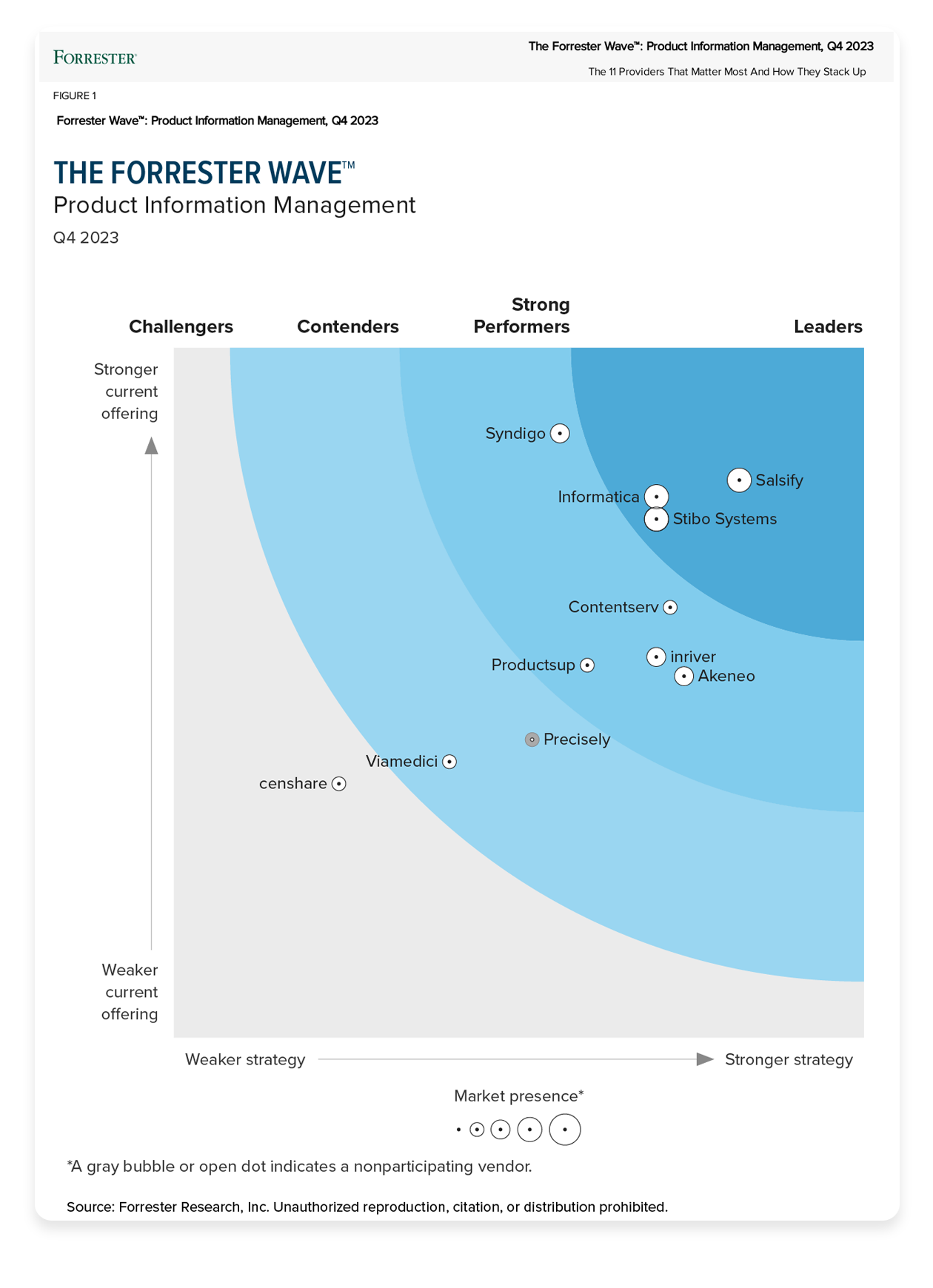Rob Gonzalez of Salsify: Reflections on the Last Decade of PIM
Written By: Rob Gonzalez
Rob Gonzalez is Salsify's chief marketing officer (CMO) and co-founder. His team drives market strategy, pipeline management, corporate marketing, retail network development, and strategic alliances. Previously, Gonzalez ran product management and marketing for Cambridge Semantics, another Boston-area startup.
Obligatory disclaimer from Gonzalez: This article is full of my own wild ideas and opinions — not Forrester's.
The 2023 Forrester PIM Wave is out, and it is very different from its earliest ancestor, which appeared nearly 10 years ago in 2014. The product information management (PIM) market has evolved considerably in the last decade.
Why?
Ecommerce. (Though "omnichannel" is a more accurate term.)
How has it evolved, technically, due to ecommerce? We'll get to that.
First, some history.
Ten years ago, ecommerce was much, much smaller than it is today. For most manufacturers, retailers, and distributors, it was well under 10% of gross sales.
A side hustle.
Amazon was only just about to crack the top 10 retailers by gross revenue and was "only" in the number 10 spot. Walmart had yet to purchase Jet.com.
Ecommerce teams were rogue parts of brand manufacturers, not well integrated, upstarts, and they were the only ones who knew or cared about the importance of managing product detail pages (PDPs) in ecommerce. They were seen as a "sales channel," and a small one at that.
Today, ecommerce is no longer a side hustle. It's no longer just a "sales channel." It impacts every channel, including in-store, and as such ecommerce operations are integrated into every single department's daily operations.
The most digitally mature companies have moved beyond tiger teams (experts brought together to solve a specific problem) and centers of excellence (experts brought together to create best practices around a specific topic), with ecommerce metrics baked into every department's standard operations, and an ecommerce leader sitting on the executive leadership team (ELT).
This has profound implications on what a PIM is used for — on what value it delivers.
According to “The Forrester Wave™: Product Information Management, Q4 2023” report: "Product information as an enterprise’s single source of truth has pivoted from singular B2B [business-to-business] or B2C [business-to-consumer] ecommerce experiences to syndication of holistic product records and thousands of online distribution channels and retailers."
PIMs — like the market — have gone from single-channel to omnichannel.
And that is a major change.
Let's break down the major technical implications on the PIM space that follow from moving from single-channel to omnichannel.
From: Single-Channel, One Version of the Truth
To: Multichannel, Many Versions of the Truth — Each Optimized for Different Sales Channels
Amazon's product experience requirements are distinct from Walmart, Kroger, or Uber Eats. They differ from Wayfair or Bed Bath & Beyond. They will never agree with Chewy.
The online experience is a field of competitive differentiation and will never be fully standardized.
If your PIM doesn't support "our version, Amazon's version, Walmart's version," then your "PIM" is, in reality, a spreadsheet — since that's what your sales team is actually using to master the content your consumers are seeing.
The PIM you’ve invested in is often not useful to your teams who must manage channel-specific requirements … which is literally everyone who touches the market.
There is no one "golden record" anymore. The "master data" approach to PIM is fundamentally anachronistic and broken.
From: Your Internal Taxonomy Team Defines Data Requirements
To: Most Data Requirements Come From What the Market Requires — and Are Therefore Volatile
Amazon, Grainger, Target: What do they have in common?
They all changed their product requirements more than 100 times in 2022.
Why?
They are constantly optimizing for better consumer search, discovery, and conversion. They are constantly innovating on better experiences.
Their requirements do not stand still. These necessary and important changes impose hugely volatile product data models on your organization.
Can your PIM handle it? If not, once again, your sales team is keying data into a spreadsheet or a supplier portal — no governance, no security, no auditing, no review, no accountability of any kind.
What good is your PIM if it can't store both your own internal taxonomy and Amazon's? And who is responsible for keeping up to speed with what your customers actually need?
From: Data Quality Measured Against Internal Standards
To: Data Quality Also Measured Against External Performance via Digital Shelf Analytics
All classic PIMs have a data quality metric. But those metrics are against internal data standards — and not even all internal data standards. (For example: Does your PIM grade you against brand voice and style?)
If you give yourself an “A” on data quality, that's great. But isn't it better if your data quality is an “A” on Target, Grainger, Intermarche, or Woolworths?
Isn't what matters, at the end of the day, the quality of the experience the consumer has with your brand and the resulting sales improvements?
PIMs are increasingly embedding digital shelf analytics capabilities and pulling in data from Profitero, CommerceIQ, IRI, or others. Retailers like Walmart are creating their own scorecards.
Does your PIM take them into account?
From: Your PIM Hosting Primarily Taxonomy, Data Attributes, and a Few Images
To: Your PIM Needs Everything All the Channels Need — Requiring Robust DAM Capabilities, Digital Catalogs, Enhanced Content Site Layouts, and More
Classic PIMs could store some product images.
Modern PIMs must store every single piece of media you might see on a PDP. This includes images, yes, but also the order of the images, which materially impacts conversion.
Also, 3D image spins, videos, enhanced content layouts, replacement parts, and more. It must support workflows around these assets as well.
It's very nearly a digital asset manager (DAM) — and, for some use cases, could be used as a DAM.
They also have to expose these media for downstream distribution. This involves resizing, renaming, reformatting, providing download links, integrating with content delivery networks (CDNs), and more.
After all, if you can't get the media in front of a consumer, it has zero value.
From: PIM Responsibility for Data Quality Ending at ‘Export’
To: PIMs Becoming Responsible for Data Quality and Performance for the Entire Product Lifecycle Across the Supply Chain
It's great that your PIM integrates with your enterprise resource planning (ERP) system. It’s better if it integrates with your ecommerce platform or web content management systems (WCMs). It’s even better if it also connects to your middleware solution.
In modern PIM deployments, integration to systems outside of a company's firewalls is equal — if not more — important.
These are the catalog and product systems of Amazon, Walmart, Southern Glazer's, Tesco, Leclerc, Woolworths, etc. The connections are via whatever mechanisms exist: API, embedded javascript on-site PDPs, Open Catalog, Global Data Synchronisation Network (GDSN), Excel templates, XML feeds, digital catalog, etc.
External connections are varied and messy, and your PIM now has to support each variety.
If you're a retailer or distributor: How friendly is the interface that you use to present your suppliers? Is it open? Does it allow for automation? How easy or hard are you making it for your suppliers to collaborate with you to deliver great product experiences to shoppers?
If you're a brand manufacturer: If your PIM can't get the data into Amazon's systems, what value is your data? What percent of shoppers see your product on Amazon, Google, Walmart, The Home Depot, Lowe's, Kroger, or Instacart versus your own website?
(Side questions: How many people see all your PDPs every month versus your TV commercials? How many are Generation Z? What is your most valuable media footprint and investment?)
The word lifecycle has "cycle" in it. Cycles return.
These external integrations are not simply "export and done." The connection is two-way. You publish data to a retailer, they review the data, and you often get back feedback.
Someone — in your PIM — has to be notified, take the feedback, act on it (like by editing copy), and republish.
From: A Point system, Often Purchased and Operated by a Single Department
To: An Enterprise Business Solution Used by All Departments
As ecommerce has become more important, PIM has become a core component of enterprise infrastructure. But we're still in the early innings here. Less than 10% of our customers have a truly global PIM strategy or implementation. In 10 years, 90% will.
Just as Salesforce and the customer relationship management (CRM) category started by being purchased by your executive vice president (EVP) of sales and later was moved to the office of the chief information officer (CIO) after it had reached a certain level of strategic importance in the enterprise architecture, so too are PIMs starting to make that migration.
This will require, more than anything, more robust workflows that can accommodate thousands of users across every major business function. It will require tighter integrations with business intelligence (BI) reporting tools and data lake strategies.
It will require more automation to meet the scale of the merchandising opportunity, increasingly powered by artificial intelligence (AI) over time. The bounds on what media gets stored in the PIM will continue to evolve with the internet, including more and more 3D assets over time. Doing all of this with efficiency and manageable costs will likely lead to consolidation in the commerce tech stack.
What’s Next? Core Themes for the Future of PIM
In the last 10 years, ecommerce has gone mainstream. PIM, as a category, has had to evolve with it. Here are the core themes that will dominate the PIM evolution in the next decade.
Tons of Automation Become Required
The cross-product of SKUs, channels, and channel changes creates a bottomless list of potential optimizations. You can't hire enough people to do everything to the highest level of quality. AI will play a big role here, as will more open, flexible, and programmable workflow systems.
Experience Management Becomes Table Stakes
PXM, as a category, is less than a decade old. It will subsume PIM. Experience management does everything a PIM does but adds robust DAM, syndication, analytics, and automation capabilities.
PIM was too small a problem to solve, which is a big reason why the category was small relative to its cousin MDM. By embracing experience management, the PIM category will become large.
Not all legacy players have the systems architecture to make this transition gracefully.
Global Enterprise Readiness and Scale
In the past, when a PIM was "just" a product database, and one often purchased by a single department (and only sometimes by IT), the number of enterprise systems touchpoints was somewhat limited. As the PIM moves into the center of an enterprise's architecture, it will have to evolve to include everything the CIO expects from leaders in ERP, CRM, enterprise service bus (ESB), and other central categories.
On behalf of our customers, we are investing to meet this challenge. By doing so, we hope to continue to earn our placement as a Leader in “The Forrester Wave™: Product Information Management, Q4 2023” report.

Salsify Named a 'Leader' in Product Information Management (PIM)
Explore the latest trends in PIM with The Forrester Wave™: Product Information Management, Q4 2023 Report, and learn why Salsify was named a “Leader.”
DOWNLOAD REPORTWritten by: Rob Gonzalez
Rob Gonzalez (he/him) is one of the co-founders of Salsify and is also the co-host of the “Unpacking the Digital Shelf” podcast. Previously, he ran product management and marketing for Cambridge Semantics.
Recent Posts
Why Do Shoppers Consider Images and Videos the Most Important Product Page Elements?
Curated Commerce: How Shopping Apps Can Boost Sales
The State of Secondhand Shopping: Circular Commerce Trends and Consumer Insights
Subscribe to the Below the Fold Newsletter
Standing out on the digital shelf starts with access to the latest industry content. Subscribe to Below the Fold, our monthly content newsletter, and join other commerce leaders.

.svg)